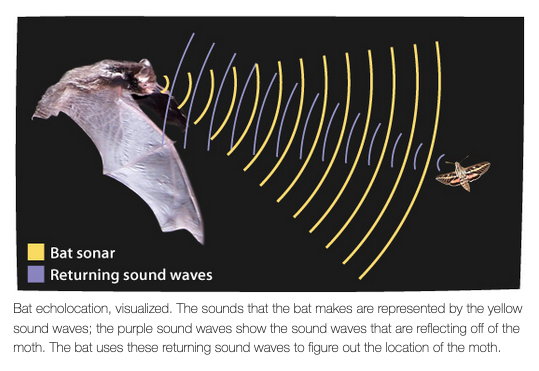Bio SonarA method or device for detecting and locating objects by means of sound waves sent out to be reflected by the objects.
In 1977, it snowed in Miami, Elvis died, scientists used bacteria in a lab to make insulin via gene cloning, Apple II computers and Atari systems went on sale, I turned 2, and the first Multibeam Echosounder became commercially available.

But for millions of years prior to 1977, bats, dolphins, and a few other types of animals have relied on the echoes of sounds they produce to help them navigate and find food. While the phrase "blind as a bat" is often used, most bats actually have the ability to see. However, many species do not rely on sight as their primary means of acquiring information about the world around them because they live or hunt in places with insufficient light. The echolocation calls used by bats are typically ultrasonic, meaning they are beyond the range of human hearing - which is fortunate, because the calls would otherwise literally be deafening. Some bats can emit sounds as loud as 120 decibels, which is louder than having a smoke detector go off just four inches from your ear and would quickly destroy your ability to hear. However, from my research I learned that bats can change the configuration of the tiny bones in their ears (which are just like the bones in our ears) for a couple of milliseconds when they emit the sound so that their ears aren't harmed by its volume, but then just as quickly change the bones back so they can hear the echo. I also learned that bats can use echolocation to detect objects as thin as a human hair in total darkness. Bats are amazing. (AJ learned some pretty cool bat facts a couple of years ago - maybe he'd like to take a few minutes on his BIRTHDAY and share them with me).

As scientists began to understand more about bats' use of echolocation, they realized humans could use a similar system of generating a noise and listening for its echo to provide information about places where light couldn't penetrate. At first, they used a single beam echo sounder to try to better understand the seafloor, which eventually evolved into the multibeam system we use on the Nathaniel B. Palmer today - one that emits and listens for the echo from 432 beams of sound sent out from a machine attached to the hull of the ship. A more detailed description of our multibeam system can be found in this post from Jeff Goodell, who traveled to Thwaites last year and wrote about his experience in Rolling Stone.
We have been dealing with some of the limitations of the ship's multibeam on this trip - mostly that it can only be deployed in places where the ship can go. When solid ice covers the sea surface, we can't access that area to map the seafloor. If you look back at the final photo I posted yesterday, a map of the bathymetry of the area in front of Pine Island GlacierA mass of ice that persists for many years and notably deforms and flows under the influence of gravity., you will notice a few black holes - places where large icebergs or the ice face itself prevent us from collecting data. And so far, our primary target for this trip - the area immediately in front of Thwaites GlacierA mass of ice that persists for many years and notably deforms and flows under the influence of gravity., has been covered in thick sea ice, making it impassable or at best impractical, even for an icebreaker like the Palmer. We just reached the halfway point of our expedition, so we have time to collect other data and wait for the ice to shift enough to let us in.
Try this at Home:
Want to test out your ability to echolocate? The Explore Sound website has a lesson plan that is profoundly unrealistic for most school settings, but might be neat to try at home. You will first test out your ability to locate objects in three dimensions - you'll need a pitch black room and a laser pointer to make it happen. Explore Sound's methods include hanging buttons from the ceiling with string, but I would suggest using fishing line if you have it - that reduces the chances that you will spot the string before you see the button. The second activity is intriguing, although I'm doubtful that I would be very good at it. You need a very quiet space (which is even more unlikely to exist in a public school building than one that is pitch black), and a number of somewhat similar objects - the website says maybe a pen, pencil, marker, crayon, Chapstick, etc. You could also try this with different coins. A blindfolded volunteer stands in the center of the silent room surrounded by a group of their silent friends. One student drops an object, and the blindfolded person has to guess both which object was dropped and point to exact place where the object hit the floor. Let me know how it goes!


Comments